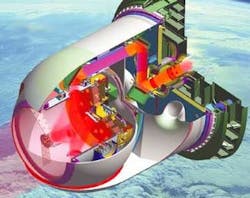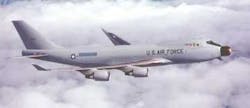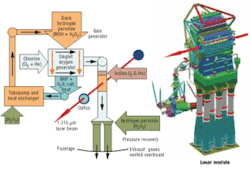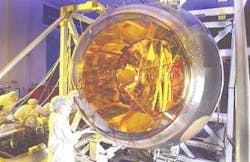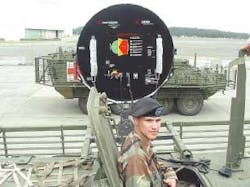The world's largest directed-energy weapon, the U.S. Defense Department's Airborne Laser, employs hundreds of complicated optics and several lasers to track down and destroy incoming missiles, and it is expected to be deployed by the end of the decade.
By John McHale
Most people get their idea of laser weapons from the movies, where colorful beams of light fire out of little ray guns, but the weapons today's military is looking to deploy are invisible to the naked eye and require a large-scale design to generate enough heat to destroy targets such as missiles. The biggest and furthest along is the U.S. Air Force Boeing Airborne Laser (ABL), being developed at the Air Force Research Laboratory Directed Energy directorate at Kirtland Air Force Base, N.M.
Its purpose is to destroy ballistic missiles during their boost phase, the period when they are moving on a relatively even, predictable path and, because of their pressurized fuel load, are particularly vulnerable to the ABL style of attack. Weather is not a factor because the Airborne Laser aircraft fly above the clouds, explains Maj. Matt Murdough, manager of weapons system integration for the ABL at Kirtland.
The 7-ton rotatable turret contains three of the system's vital elements: the primary mirror, the secondary mirror, and the conformal window.
At first, ABL was part of the Air Force's Space and Missile Systems Center (SMC), but ABL moved in 2001 to the Aeronautical Systems Center (ASC), which oversees combat aircraft. Almost simultaneously, the program's management role transferred to the Missile Defense Agency (MDA). In practice, ASC will be responsible for ABL's personnel and MDA for program execution.
The ABL system, which flies aboard a Boeing 747-400 jumbo jet, is scheduled to take to the skies again this year and is set to shoot down its first ballistic missile in a test over the Pacific Ocean in 2005.
Although Boeing Integrated Defense Systems in St. Louis is responsible for the aircraft, Lockheed Martin Missiles and Space division in Sunnyvale, Calif., constructed the turret and the optical system. The megawatt-class Chemical Oxygen Iodine Laser (COIL) that will destroy ballistic missiles comes from the Northrop Grumman Space Technology division in Redondo Beach, Calif. Boeing also engineered the battle-management system and is responsible for seeing that the subsystems are integrated into the aircraft. The program is under the management of the Missile Defense Agency (MDA).
The lasers
A laser beam is one form of directed energy — similar in concept to sunlight focused through a magnifying glass, a directed burst of microwave energy, or a bullet fired from a gun. The word "LASER" is an acronym for Light Amplification by Stimulated Emission of Radiation — scientific words used to describe the process that produces the unique form of energy.
Lasers emit flashes of light, called photons, when an excited atom releases excess energy and returns to its preferred ground-state energy level. A laser beam results when a large collection of the same type of atoms produces photons nearly simultaneously.
In a beam, the photons move in step (in phase) with each other and travel in the same direction (coherence), Kirtland officials say. The laser system concentrates the beam by collecting, optically manipulating, and amplifying the emitted photons, and propagates the beam at a specific wavelength, which depends on the type of atom used.
The U.S. Air Force Airborne Laser flies aboard a modified Boeing 747.
Four lasers make up the ABL: the Active Ranger System (ARS), the Track Illuminator Laser (TILL), the Beacon Illuminator Laser (BILL), and the COIL.
On a mission, the ARS is the first to fire. The carbon-dioxide (CO2) continuous laser propagates at a wavelength of 11.15 microns, and sends a beam to the proposed target using the returned signal to produce continuous, high-resolution tracking data. Associated software prioritizes the sequence of targets to be destroyed.
The ARS was taken from a C-130 plane but has caused too much turbulence on the 747 platform and is being redesigned, says Ken Englade, with Kirtland public affairs.
The TILL is a solid-state laser called a Yb:YAG because its lasing medium is a ytterbium: yttrium aluminum garnet, Kirtland officials say. It produces a pulsed laser beam that propagates at a wavelength of 1.03 microns. The TILL illuminates the body of the missile, Murdough says. It locates and stabilizes the nose in the field of view of highly specialized cameras that help track the missile.
The BILL, meanwhile, is a pulsed Nd:YAG laser that uses a neodymium: yttrium aluminum garnet as its lasing medium. The beam from the BILL bounces off the target and returns to the aircraft, where sophisticated optical/software equipment measures and compensates for the amount of distortion in the atmosphere between the aircraft and the target, Kirtland officials say. The heat waves that can be seen rising off hot pavement in the summertime are the type of atmosphere distortion that can affect a laser, Murdough explains.
The BILL and the TILL are kilowatt-class lasers, producing energy on the order of 1,000 watts. In comparison, a common laser pointer produces energy of 0.001 to 0.005 watts.
The COIL, which actually destroys the target, is a 1.5-meter-diameter laser that heats the skin of the missile, causing it to deform and resulting in internal depressurization, which causes the missile to explode, Murdough says. However, contrary to popular belief, the laser does not actually burn a hole in the missile, he adds.
The COIL-laser section is composed of six identical modules. Each module weighs roughly 4,500 pounds and is the size of a "Chevy Suburban turned on its end," says Maj. Mark Skouson, Battle Management C4I product team leader on the ABL program at Kirtland. It is a continuous-wave laser that propagates at a wavelength of 1.315 microns, a wavelength chosen specifically because its beam travels well through the atmosphere. In other words, little of the beam's energy is absorbed en route to the target. Iodine is its lasing medium.
The diagram above shows how the Chemical Oxygen Iodine Laser (COIL) functions.
The COIL works by first injecting chlorine gas into an extremely fine spray of mixed-base hydrogen peroxide (MHP), a mixture of basic hydrogen peroxide (BHP) and three salts — sodium, potassium, and lithium hydroxide, Kirtland officials say. When the chlorine and MHP interact, they produce excited oxygen atoms, which mix with iodine atoms. The extra energy transfers from the oxygen to the iodine atoms; when the excited iodine atoms return to their ground state, they create photons, which produce the laser beam.
One module (LM-1) of the six that will be installed in the ABL has been tested, producing 118 percent of anticipated power, Kirtland officials say. After it was tested, LM-1 shipped to Edwards Air Force Base, Calif., and five clones were constructed. After the six-module laser section has been tested, it will be integrated into the ABL aircraft.
Optics
Beam Control/Fire Control (BC/FC) is the ocular system, the super-sensitive complex of lenses and mirrors that ensure the lethality of the ABL system, Kirtland officials say.
The BC/FC system stretches from the turret on the front of the Boeing 747-400 Freighter to an area behind an airtight bulkhead that protects the crew from possible chemical leaks. The system's 127 optics (mirrors, lenses, and windows) range in size from 1 inch to 5.5 feet in diameter; in addition, many of the optics are unique to ABL and represent state-of-the-art glass manufacturing and optical coating, Kirtland officials say.
There are also a couple of hundred additional minor optics in use throughout the system, Murdough says.
The BC/FC system safely controls the high- and low-energy laser beams propagated through the aircraft, and is crucial to ABL's kill mechanism. After locking on to a missile, the system tracks it, compensates for atmospheric distortion between the target and aircraft, and, finally, fires the high-energy laser onto the missile's fuel tank, causing the missile skin to rupture.
The complex BC/FC system is composed of three major assemblies. One assembly — the Multi-Beacon Illuminator (MBIL) bench — is located over the wings. It houses the TILL, which stabilizes the target in the onboard cameras, and the BILL, which corrects for the atmospheric disturbance between the aircraft and the target. The MBIL weighs about 6,000 pounds.
The Beam Transfer Assembly (BTA) — the second of the three — is located forward of the MBIL, approximately under the cockpit. It holds ABL's sensitive cameras, sensors, deformable and steering mirrors, and other specialized optics and electronics that enable the system to track and kill its target.
The third major assembly is the 7-ton rotatable turret. It contains, among other hardware, three of the system's vital elements: the primary mirror, the secondary mirror, and the conformal window.
The 58.8-inch, gold-plated primary mirror and the 12.2-inch secondary mirror form a large telescope, which is the heart of the ABL kill chain. Beams from all of ABL's lasers — which all propagate at different wavelengths — must touch these two mirrors on their journey to engage the target missile. By design, the laser beams enter the turret through an elbow-like passageway called a coude path. If the system had been set up to fire beams directly out of the aircraft, the flight crew would have had to turn the plane to aim the lasers. By using the rotating turret, the aircraft remains on a steady course, Kirtland officials say.
When firing from the aircraft, the beams first strike the secondary mirror and bounce to the primary mirror, where they expand and reflect through the conformal window, a 5.5-foot "contact lens," which took nearly four years to develop, Murdough says. It is durable enough to withstand tremendous aerodynamic forces and still remain transparent to the megawatt-class beam from ABL's high-energy laser as it passes through.
"A glass that could survive under these conditions did not exist and had to be invented," Murdough adds. Making optics this size to fly on a plane has never been done before. Optics of similar size have been used on telescopes, but never in the air as part of a laser weapon, so many had to be developed from scratch, Murdough says.
One of the greatest challenges to the ABL involves manufacturing and coating of specialized optics, which include nearly the entire BC/FC system, Kirtland officials claim. Each lens and mirror in the system has to be coated by applying fine layers of gold and other materials in a delicate integrated fashion.
Simply painting a lens as if it were a wall is ineffective. Because many of the optics must be able to perform dual duty by reflecting and transmitting high-intensity laser beams at different wavelengths, the coatings must be multipurpose to keep the optics from being damaged or destroyed. One coating typically makes an untreated glass reflective (turns it into a mirror), while another coating on the same optic might make it transmissive (turns it into a window), Kirtland officials say.
Other parts in the BC/FC system are the atmospheric-compensation deformable mirrors. They have a thin membrane surface backed by hundreds of tiny, finger-like actuators that move thousands of times per second in reaction to readings from the BILL, which serves as a sort of radar to paint a picture of the atmosphere between the aircraft and the target.
Battle management
The Battle Management, Command, Control, Communications, Computers, and Intelligence — better known as BMC4I — controls the ABL's mission. The system finds and tracks boosting enemy missiles, selects which missile to target, and decides when to blast it with the COIL, Kirtland officials say.
The speeds of the incoming targets require computer control rather than human control of the ABL system, Kirtland officials say. The missiles average speeds in excess of 1,500 mph, or 4.5 mps.
ABL flight engineers provide the limits under which the system operates on automatic mode and constantly monitor operations so they can intervene if necessary.
The BMC4I system is divided into four consoles (there are eight on the first aircraft because four are dedicated to collecting test data), a Mission Data Processor (MDP), and a sophisticated communication system that includes Link 16, an audio hook-up that enables ABL to interact with other military units in and out of the battle zone.
The MDP takes care of mission data, mission planning, sensors, and surveillance, while also prioritizing targets, performing kill assessment, and avoiding shooting down any satellites by mistake, says Skouson. The flight engineers are given lists of satellites at the beginning of the mission and then, through time- vectoring and updates from the ground, determine where the satellites are throughout the mission, Skouson says.
The main computer uses four Alpha processors, originally made by the Digital Equipment Corp. later purchased by Compaq, and still later by Hewlett Packard. The system runs a Unix real-time-operating system (RTOS) designed for the Alphas, Skouson says. The four consoles use only one Alpha processor each and run the Unix RTOS.
The old processors are adequate for the job. The only computer that is not Alpha-based is the I/O processor, which uses a Pentium and runs the VxWorks RTOS from Wind River Systems in Alameda, Calif. Active and passive sensors are being upgraded to improve surveillance, Skouson says.
This equipment is spread around the interior and exterior of the aircraft, but the consoles and other sensitive pieces of hardware are located over the wings on the main level of the aircraft.
Flight engineers include a mission commander, an airborne-surveillance officer, a weapon-system officer, and a special-equipment operator.
The more active roles are fulfilled by the major BMC4I components: the six Infrared Search and Track (IRST) units placed strategically around the exterior of the aircraft; the Active Ranging System (ARS), a continuous-wave, carbon dioxide laser located on the top of the "hump"; the MDP; and the consoles, each of which was built from off-the-shelf hardware. The software, however, was written specifically to meet ABL's needs.
The six IRST units are spread around the plane: front, back, and two on each side. The IRSTs also work with four global-positioning-system (GPS) devices, Skouson says: one on the front, one on the back, and one centrally located on each side of the aircraft.
Data used to help create the mission plan include intelligence on missiles of a certain type located in a specific area within ABL's operational zone, or details about a friendly area that is on the top of the "defend" list. Mission planning information can be modified in flight.
Once ABL moves into attack range, the system is enabled in automatic mode. A typical mission is designed to work this way:
- heat-seeking IRSTs detect the plume of a launching missile;
- the system transfers this data to the ARS, which provides range, speed, and acceleration information;
- the MDP calculates the missile's rough track, estimates its launch point, and determines if it is a potential target;
- the system provides refined information (including probable impact point), initiates the engagement sequence by locking onto the target, and prepares the COIL to fire; and
- once the target missile has been destroyed, BMC4I evaluates system performance and prioritizes remaining missiles.
BMC4I was the first of ABL's major systems to be installed and flight-tested on the aircraft, Kirtland officials say. It was aboard and essentially complete when the aircraft — prototype Attack Laser model 1-A (YAL-1A) — made its maiden flight during the summer of 2002. It was repeatedly tested — first against the plumes of F-16 afterburners, then a boosting Lance missile, and finally against a staging Minuteman II missile in a test over the Pacific Ocean at the end of 2002.
DIRECTED-ENERGY WEAPONS
Marine Corps to use American Technology Corp. sonic-energy device in Iraq
Engineers at American Technology Corp. (ATC) in San Diego provide nonlethal long-range acoustic devices (LRADs) to U.S. military units stationed in Iraq to help improve security. ATC has delivered LRADs to augment the Force Protection Kits of the 1st Marine Expeditionary Force out of Camp Pendleton, Calif., and the 3rd Marine Aircraft Wing out of Miramar Naval Air Station, Calif.
The U.S. Army 3rd Battalion 2nd Infantry Stryker Brigade in Mosul, Iraq, is also using the LRADs, says Carl Gruenler, vice president of ATC's government and force-protection systems division.
LRAD is a long-range hailing-and-warning directed acoustic device that is designed to determine intent, change behavior, and support various rules of engagement, ATC officials say.
With LRAD, a sentry can issue a focused verbal challenge with instructions in excess of 300 yards and follow up with a warning tone to cause behavior change. The device has a range of more than 500 yards over water, Gruenler says. "The sound wave actually gets tighter at longer distances."
Recorded messages can also be selected and delivered over LRAD in multiple languages. "Before LRAD, soldiers in the field were actually still using bullhorns," Gruenler says.
"LRAD is a significant addition to the Force Protection Kits being deployed into the Iraqi theater," says Lt. Col. Susan Noel, force-protection officer for the 1st Marine Expeditionary Force. "These devices provide a critical new tool to place distance between the Marine and the threat, giving him/her more time to sort out a measured and appropriate response."
"LRAD addresses the capability gap that exists for key mission tasks, including crowd control, area denial of personnel in-cluding checkpoint operations, and clearing buildings," says retired USMC Col. Peter Dotto, the program director at M2 Technologies, Inc. M2 is the systems integrator for the USMC Systems Command that is evaluating nonlethal weapons.
"Determining intent at distances which extend the decision time to classify and deal with potential threats is increasingly critical in government, military, and industry efforts to protect lives and assets," Gruenler says. "Providing an effective less-than-lethal tool to communicate, affect behavior, and support lethal rules of engagement better equips our service men and women for new and dangerous missions. We believe LRAD can save lives on both sides of the device, and provide a much needed defense-in-depth capability to protect critical assets and infrastructure."
The attack on the destroyer USS Cole was the genesis for this technology, Gruenler says. At that time, putting a boat in the water was the only way to possibly challenge that type of intrusion, he says.
The LRAD enables security to send a loud ping at the person, then follow it up with a voice or a louder burst to change the person's behavior and make him/her leave the secure area. Gruenler says. In other words, any normal person would leave because the noise would be so uncomfortable, "just like leaving a hand too long on a hot stove," he continues. If someone continues to advance even after the behavior-change mode, then security will assume that person or persons is a threat and take appropriate measures, Gruenler says.
However, this is technically not a nonlethal weapon, because it does not completely stop someone, but it is pretty close, he says.
It cannot create a burst of sound so loud that it bursts someone's eardrum, Gruenler says. "To be able to accomplish that at long distances would require stretching the laws of physics as we know them," Gruenler explains.
"The LRAD can create a burst at approximately 151 decibels and can sustain it at 146 decibels," he says. The initial warning tone will be 120 decibels and the voice tone would be approximately the same depending on the qualities of the voice, Gruenler says. Earplugs will decrease the volume but not the effectiveness of the device, he adds.
ATC officials also recently announced an additional contract for LRADs from the 24th Marine Expeditionary Unit from Camp Lejeune, N.C.
The Rapid Equipping Force (REF) of the U.S. Army previously purchased and deployed LRADs in Iraq to develop a concept of operations for vehicle-mounted use. The REF is a major conduit for new technology into the warfighting forces, ATC officials say.
For more information on LRADs and ATC, visit the company online at www.atcsd.com.
